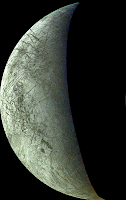
 |
I can't take credit, though. It was inspired by this:
 |
<3 xkcd
|
Quote:
oh! cool! googled that-- awesome! |
So there's all sort of rumours and speculation going on at the moment, concerning the Mars Phoenix Lander.
Quote:
http://www.planetary.org/blog/article/00001584/ Quote:
All very interesting |
^^^ it was perchlorate salt. not so good for life, but it's good for making solid rocket fuel.
Barsoomian sunrise:  |
http://www.nytimes.com/2008/09/18/sc...ml?ref=science
 Astronomers from the University of Toronto have published a picture of what they say might be the first image of a planet orbiting another Sunlike star. The planet, according to their observations, is 7 to 12 times as massive as Jupiter and is about 30 billion miles from a star known as 1RXS J160929.1-210524, about 500 light-years away in the constellation Scorpius. The picture was taken last spring by the 270-inch diameter Gemini North Telescope on Hawaii’s Mauna Kea, using so-called adaptive optics to reduce atmospheric blurring and thus sharpen the images of both star and planet. This is at least the third so-called exoplanet candidate that astronomers have photographed. In 2004, a group from the European Southern Observatory in Chile photographed a red speck about five times the mass of Jupiter orbiting a kind of failed star known as a brown dwarf in the constellation Hydra. In 2005, another group photographed an object that they estimated to be twice as massive as Jupiter orbiting the star GQ Lupi, but other astronomers said the object could be as much as 36 Jupiters in mass, making it not a planet but a brown dwarf. The Toronto astronomers say it will take several years to determine whether their planet is moving through space with the star and thus is really a planet. In the meantime, theorists can puzzle about how it could come to live 60 times farther from its star than Jupiter is from the Sun. |
 http://blog.wired.com/wiredscience/2...-x-did-it.html The first privately developed space vehicle has successfully reached space from a ground launch. |
 September 28, 2008 ANCHORAGE — Soon after Sarah Palin was elected mayor of the foothill town of Wasilla, Alaska, she startled a local music teacher by insisting in casual conversation that men and dinosaurs coexisted on an Earth created 6,000 years ago -- about 65 million years after scientists say most dinosaurs became extinct -- the teacher said. After conducting a college band and watching Palin deliver a commencement address to a small group of home-schooled students in June 1997, Wasilla resident Philip Munger said, he asked the young mayor about her religious beliefs. Palin told him that "dinosaurs and humans walked the Earth at the same time," Munger said. When he asked her about prehistoric fossils and tracks dating back millions of years, Palin said "she had seen pictures of human footprints inside the tracks," recalled Munger, who teaches music at the University of Alaska in Anchorage and has regularly criticized Palin in recent years on his liberal political blog, called Progressive Alaska. The idea of a "young Earth" -- that God created the Earth about 6,000 years ago, and dinosaurs and humans coexisted early on -- is a popular strain of creationism. more: http://www.latimes.com/news/politics...,3643718.story |
This is NOT all things pseudo-science.
anyways, this xkcd strip is awesome  |
|
Quote:
very choose yr own adventure sci fi picture novel type illustration(not that I would know). I love it. |
 |
|
 |
|
Science and math, as humans conduct them, are just a large application of logic, and logic, as we all know, is completely unreliable.
Quote:
|
|
Quote:
yeah.....right. so you think that sometimes 2 + 2 is not 4? sounds like newspeak/doublethink to me son! go back to north korea! |
Quote:
Maybe I will! Keep in mind that while all arithmetic is math, not all math is arithmetic... |
Last night I read the first 5 chapters of Relativity while stoned out of my mind, and I'm proud to announce that I now understand the universe.
String theory is on the right track, but they've got a ways to go. |
what about M-theory? or Brane Theory?
|
That means nothing. An old roommate and I stayed up until 6 in the morning and we finally figured out what the 4th dimension is. I would explain it to you, but I doubt you would understand (no offense).
|
individual atoms in action
http://www.youtube.com/watch?v=Eogda...layer_embedded take that anti-atomists! |
Quote:
|
Quote:
Thems's jus DEAMONS tryin' ta make ya THANK ya see ADOMS! |
Photoshopped. The non-shadows are all wrong.
|
http://www.cnn.com/2009/TECH/space/0...age/index.html
Would you guys go on a mission to space given the opportunity? |
I'm uncomfortable when people that're meant to be highly exact use words like 'dings'. It's like a doctor diagnosing you as being 'poorly'.
|
Quote:
yes i'd love to i'm a space dorkface, no matter what the risks are - the idea of looking down at that brilliant blue marble is too appetising to turn down |
Quote:
|
Quote:
hell yeah I would. I'd go NOW |
Quote:
|
fuck stupid people.
I want to know what the scientific odds are of me interfacing with I -Fuppets- EVERYTHING I KILL. I want to -Fuppets- her real bad. |
^^^ I hear ya, man.
Parasitic flies turn fire ants into zombies By Bill Hanna, Fort Worth Star-Telegram – Tue May 12, 2:09 pm ET It sounds like something out of science fiction: zombie fire ants. But it's all too real. Fire ants wander aimlessly away from the mound. Eventually their heads fall off, and they die. The strange part is that researchers at the University of Texas at Austin and Texas A&M's AgriLife Extension Service say making "zombies" out of fire ants is a good thing. "It's a tool — they're not going to completely wipe out the fire ant, but it's a way to control their population," said Scott Ludwig , an integrated pest management specialist with the AgriLife Extension Service in Overton , in East Texas . The tool is the tiny phorid fly, native to a region of South America where the fire ants in Texas originated. Researchers have learned that there are as many as 23 phorid species along with pathogens that attack fire ants to keep their population and movements under control. So far, four phorid species have been introduced in Texas . The flies "dive-bomb" the fire ants and lay eggs. The maggot that hatches inside the ant eats away at the brain, and the ant starts exhibiting what some might say is zombie-like behavior. "At some point, the ant gets up and starts wandering," said Rob Plowes, a research associate at UT. The maggot eventually migrates into the ant's head, but Plowes said he "wouldn't use the word 'control' to describe what is happening. There is no brain left in the ant, and the ant just starts wandering aimlessly. This wandering stage goes on for about two weeks." About a month after the egg is laid, the ant's head falls off and the fly emerges ready to attack any foraging ants away from the mound and lay eggs. Plowes said fire ants are "very aware" of these tiny flies, and it only takes a few to cause the ants to modify their behavior. "Just one or two flies can control movement or above-ground activity," Plowes said. "It's kind of like a medieval activity where you're putting a castle under siege." Researchers began introducing phorid species in Texas in 1999. The first species has traveled all the way from Central and South Texas to the Oklahoma border. This year, UT researchers will add colonies south of the Metroplex at farms and ranches from Stephenville to Overton . It is the fourth species introduced in Texas. Fire ants cost the Texas economy about $1 billion annually by damaging circuit breakers and other electrical equipment, according to a Texas A&M study. They can also threaten young calves. Determining whether the phorid flies will work in Texas will take time, perhaps as long as a decade. "These are very slow acting," Plowes said. "It's more like a cumulative impact measured across a time frame of years. It's not an immediate silver bullet impact." The flies, which are USDA -approved, do not attack native ants or species and have been introduced in other Gulf Coast states, Plowes said. Despite initial concerns, farmers and ranchers have been willing to let researchers use their property to establish colonies. At the Texas and Southwestern Cattle Raisers Association in Fort Worth in March, Plowes said they found plenty of volunteers. |
Here is the top 10 controversial pieces of evidence for extraterrestrial life...
 1. 1976, The Viking Mars landers detect chemical signatures indicative of life 1. 1976, The Viking Mars landers detect chemical signatures indicative of lifeTests performed on Martian soil samples by NASA's Viking landers hinted at chemical evidence of life. One experiment mixed soil with radioactive-carbon-labelled nutrients and then tested for the production of radioactive methane gas. The test reported a positive result. The production of radioactive methane suggested that something in the soil was metabolising the nutrients and producing radioactive gas. But other experiments on board failed to find any evidence of life, so NASA declared the result a false positive. Despite that, one of the original scientists - and others who have since re-analysed the data - still stand by the finding. They argue that the other experiments on board were ill-equipped to search for evidence of the organic molecules - a key indicator of life.  2. 1977, The unexplained extraterrestrial "Wow!" signal is detected by an Ohio State University radio telescope 2. 1977, The unexplained extraterrestrial "Wow!" signal is detected by an Ohio State University radio telescopeIn August 1977 an Ohio State University radio telescope detected an unusual pulse of radiation from somewhere near the constellation Sagittarius. The 37-second-long signal was so startling that an astronomer monitoring the data scrawled "Wow!" on the telescope's printout. The signal was within the band of radio frequencies where transmissions are internationally banned on Earth. Furthermore, natural sources of radiation from space usually cover a wider range of frequencies. As the nearest star in that direction is 220 million light years away, either a massive astronomical event - or intelligent aliens with a very powerful transmitter would have had to have created it. The signal remains unexplained.  3. 1996, Martian "fossils" are discovered in meteorite ALH84001 from Antarctica 3. 1996, Martian "fossils" are discovered in meteorite ALH84001 from AntarcticaNASA scientists controversially announced in 1996 that they had found what appeared to be fossilised microbes in a potato-shaped lump of Martian rock. The meteorite was probably blasted off the surface of Mars in a collision, and wandered the solar system for some 15 million years, before plummeting to Antarctica, where it was discovered in 1984. Careful analysis revealed that the rock contained organic molecules and tiny specs of the mineral magnetite, sometimes found in Earth bacteria. Under the electron microscope, NASA researchers also claimed to have spotted signs of "nanobacteria". But since then much of the evidence has been challenged. Other experts have suggested that the particles of magnetite were not so similar to those found in bacteria after all, and that contaminants from Earth are the source of the organic molecules. A 2003 study also showed how crystals that resemble nanobacteria could be grown in the laboratory by chemical processes.  4. 2001, More rigorous calculations connected to the 1960s "Drake equation" suggests that our galaxy may contain hundreds of thousands of life-bearing planets 4. 2001, More rigorous calculations connected to the 1960s "Drake equation" suggests that our galaxy may contain hundreds of thousands of life-bearing planetsIn 1961 US radio astronomer Frank Drake developed an equation to help estimate the number of planets hosting intelligent life - and capable of communicating with us - in the galaxy. The Drake equation multiplies together seven factors including: the formation rate of stars like our Sun, the fraction of Earth-like planets and the fraction of those on which life develops. Many of these figures are open to wide debate, but Drake himself estimates the final number of communicating civilisations in the galaxy to be about 10,000. In 2001, a more rigorous estimate of the number of life-bearing planets in the galaxy - using new data and theories - came up with a figure of hundreds of thousands. For the first time, the researchers estimated how many planets might lie in the "habitable zone" around stars, where water is liquid and photosynthesis possible. The results suggest that an inhabited Earth-like planet could be as little as a few hundred light years away. |
5. 2001, The red tinge of Jupiter's moon Europa proposed to be due to frozen bits of bacteria, which also helps explain the mysterious infrared signal it gives offAlien microbes might be behind Europa's red tinge, suggested NASA researchers in 2001. Though the surface is mostly ice, data shows it reflects infrared radiation in an odd manner. That suggests that something - magnesium salts perhaps - are binding it together. But no one has been able to come up with the right combination of compounds to make sense of the data.
Intriguingly, the infrared spectra of some Earthly bacteria - those that thrive in extreme conditions - fits the data at least as well as magnesium salts. Plus, some are red and brown in colour, perhaps explaining the moon's ruddy complexion. Though bacteria might find it difficult to survive in the scant atmosphere and -170°C surface temperature of Europa, they might survive in the warmer liquid interior. Geological activity could then spew them out periodically to be flash frozen on the surface.  6. 2002, Russian scientists argue that a mysterious radiation-proof species of microbe may have evolved on Mars 6. 2002, Russian scientists argue that a mysterious radiation-proof species of microbe may have evolved on MarsIn 2002 Russian astrobiologists claimed that super-hardy Deinococcus radiourans evolved on Mars. The microbe can survive several thousand times the radiation dose that would kill a human. The Russians zapped a population of the bacteria with enough radiation to kill 99.9%, allowed the survivors to repopulate, before repeating the cycle. After 44 rounds it took 50 times the original dose of radiation. They calculated that it would take many thousands of these cycles to make common microbe E.coli as resilient as Deinococcus. And on Earth it takes between a million and 100 million years to encounter each dose of radiation. Therefore there just has not been enough time in life's 3.8 billion year history on Earth for such resistance to have evolved, they claim. By contrast, the surface of Mars, unprotected by a dense atmosphere, is bombarded with so much radiation that the bugs could receive the same dose in just a few hundred thousand years. The researchers argue that Deinococcus's ancestors were flung off of Mars by an asteroid and fell to Earth on meteorites. Other experts remain sceptical.  7. 2002, Chemical hints of life are found in old data from Venus probes and landers. Could microbes exist in Venusian clouds? 7. 2002, Chemical hints of life are found in old data from Venus probes and landers. Could microbes exist in Venusian clouds?Life in Venus' clouds may be the best way to explain some curious anomalies in the composition of its atmosphere, claimed University of Texas astrobiologists in 2002. They scoured data from NASA's Pioneer and Magellan space probes and from Russia's Venera Venus-lander missions of the 1970s. Solar radiation and lightning should be generating masses of carbon monoxide on Venus, yet it is rare, as though something is removing it. Hydrogen sulphide and sulphur dioxide are both present too. These readily react together, and are not usually found co-existing, unless some process constantly is churning them out. Most mysterious is the presence of carbonyl sulphide. This is only produced by microbes or catalysts on Earth, and not by any other known inorganic process. The researchers' suggested solution to this conundrum is that microbes live in the Venusian atmosphere. Venus's searing hot, acidic surface may be prohibitive to life, but conditions 50 kilometres up in the atmosphere are more hospitable and moist, with a temperature of 70°C and a pressure similar to Earth.  8. 2003, Sulphur traces on Jupiter's moon Europa may be the waste products of underground bacterial colonies 8. 2003, Sulphur traces on Jupiter's moon Europa may be the waste products of underground bacterial coloniesIn 2003, Italian scientists hypothesised that sulphur traces on Europa might be a sign of alien life. The compounds were first detected by the Galileo space probe, along with evidence for a volcanically-warmed ocean beneath the moon's icy crust. The sulphur signatures look similar to the waste-products of bacteria, which get locked into the surface ice of lakes in Antarctica on Earth. The bacteria survive in the water below, and similar bacteria might also thrive below Europa's surface, the researchers suggest. Others experts rejected the idea, suggesting that the sulphur somehow originates from the neighbouring moon Io, where it is found in abundance.  9. 2004, Methane in the Martian atmosphere hints at microbial metabolism 9. 2004, Methane in the Martian atmosphere hints at microbial metabolismIn 2004 three groups - using telescopes on Earth and the European Space Agency's Mars Express orbiting space probe - independently turned up evidence of methane in the atmosphere. Nearly all methane in our own atmosphere is produced by bacteria and other life. Methane could also be generated by volcanism, the thawing of frozen underground deposits, or delivered by comet impacts. However, the source has to be recent, as the gas is rapidly destroyed on Mars or escapes into space. In January 2005, an ESA scientist controversially announced that he had also found evidence of formaldehyde, produced by the oxidation of methane. If this is proved it will strengthen the case for microbes, as a whopping 2.5 million tonnes of methane per year would be required to create the quantity of formaldehyde postulated to exist. There are ways to confirm the presence of the gas, but scientists will need to get the equipment to Mars first. |
 10. 2004, A mysterious radio signal is received by the SETI project on three occasions - from the same region of space In February 2003, astronomers with the search for extraterrestrial intelligence (SETI) project, used a massive telescope in Puerto Rico to re-examine 200 sections of the sky which had all previously yielded unexplained radio signals. These signals had all disappeared, except for one which had become stronger. 10. 2004, A mysterious radio signal is received by the SETI project on three occasions - from the same region of space In February 2003, astronomers with the search for extraterrestrial intelligence (SETI) project, used a massive telescope in Puerto Rico to re-examine 200 sections of the sky which had all previously yielded unexplained radio signals. These signals had all disappeared, except for one which had become stronger.The signal - widely thought to be the best candidate yet for an alien contact - comes from a spot between the constellations Pisces and Aries, where there are no obvious stars or planets. Curiously, the signal is at one of the frequencies that hydrogen, the most common element, absorbs and emits energy. Some astronomers believe that this is a very likely frequency at which aliens wishing to be noticed would transmit. Nevertheless, there is also a good chance the signal is from a never-seen-before natural phenomenon. For example, an unexplained pulsed radio signal, thought to be artificial in 1967, turned out to be the first ever sighting of a pulsar. source: http://planet-pictures.blogspot.com/ good blog |
Quote:
same....zombie ants are fucking cool. |
#4 is one of my faves!!!!!!!!!!!!!11
EDIT: Thsi is some cool shiz for realz./ |
| All times are GMT -5. The time now is 08:25 AM. |
Powered by vBulletin Version 3.5.4
Copyright ©2000 - 2025, Jelsoft Enterprises Ltd.
All content ©2006 Sonic Youth